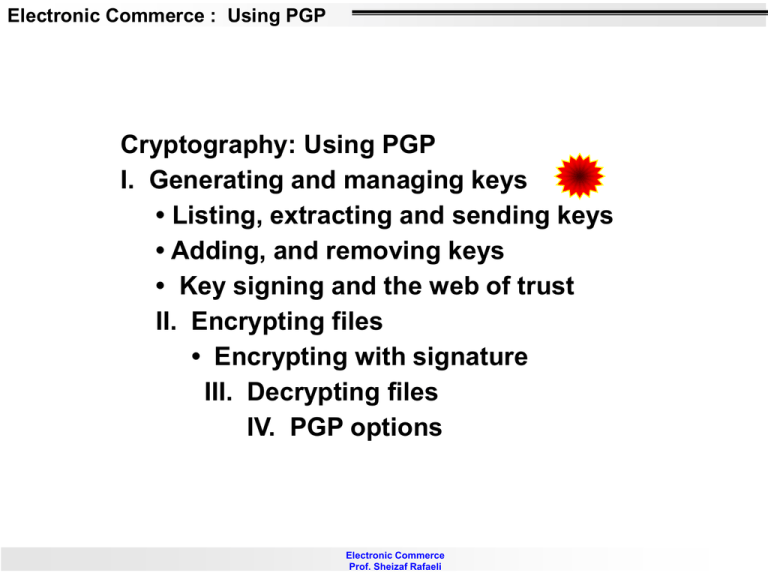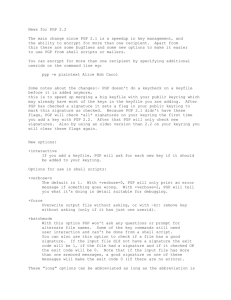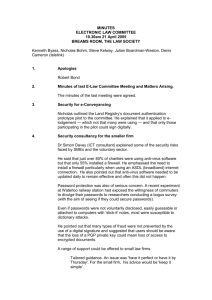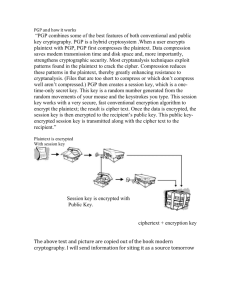Using PGP
advertisement

Electronic Commerce : Using PGP Cryptography: Using PGP I. Generating and managing keys • Listing, extracting and sending keys • Adding, and removing keys • Key signing and the web of trust II. Encrypting files • Encrypting with signature III. Decrypting files IV. PGP options Electronic Commerce Prof. Sheizaf Rafaeli Electronic Commerce : Using PGP Cryptography: Using PGP I. Generating and managing keys Note: To use PGP while using “pine” you may begin at the <pine> menu and then type: "!" This will put you at in the UNIX shell Electronic Commerce Prof. Sheizaf Rafaeli Electronic Commerce : Using PGP Generating a Key 1. To create your PGP directory, at the UNIX prompt type: mkdir .pgp 2. To start up the PGP software, at the UNIX prompt, type: pgp -kg [Key generation] 3. Choose a key size. For faster operation, choose "1" (512 bits) For more secure operation, choose “3" (1024 bits) Electronic Commerce Prof. Sheizaf Rafaeli Electronic Commerce : Using PGP 4. Enter a user ID that your key will be known by - use Firstname Lastname <yourID@study.haifa.ac.il> (You should use your name and username) 5. Your private key will be encrypted so that if it is lost, someone else cannot use it You must type in a passphrase that will be used to encrypt your password The passphrase can be as long as you want, and can include punctuation 6. The computer will generate some random number to use to create the keys Wait until the system responds that the keys have been generated Electronic Commerce Prof. Sheizaf Rafaeli Electronic Commerce : Using PGP You see: I won’t repeat this again ezmail% mkdir pgp Type 'exit' to return to Pine. ezmail% pgp -kg Pretty Good Privacy(tm) 2.6.2 - Public-key encryption for the masses (c) 1990-1994 Philip Zimmermann, Phil's Pretty Good Software. 11 Oct 94 Uses the RSAREF(tm) Toolkit, which is copyright RSA Data Security, Inc Distributed by the Massachusetts Institute of Technology. Export of this software may be restricted by the U.S. government. Current time: 1998/02/03 21:59 GMT Electronic Commerce Prof. Sheizaf Rafaeli Electronic Commerce : Using PGP And: Pick your RSA key size: 1) 512 bits- Low commercial grade, fast but less secure 2) 768 bits- High commercial grade, medium speed, good security 3) 1024 bits- "Military" grade, slow, highest security Choose 1, 2, or 3, or enter desired number of bits: 1 Electronic Commerce Prof. Sheizaf Rafaeli Electronic Commerce : Using PGP You see: Choose 1, 2, or 3, or enter desired number of bits: 1 Generating an RSA key with a 512-bit modulus. You need a user ID for your public key. The desired form for this user ID is your name, followed by your E-mail address enclosed in <angle brackets>, if you have an E-mail address. For example: John Q. Smith <!2345.6789@compuserve.com> Enter a user ID for your public key: Rafaeli <sheizaf@gsb.haifa.ac.il> Electronic Commerce Prof. Sheizaf Rafaeli Sheizaf Electronic Commerce : Using PGP You see: You need a pass phrase to protect your RSA secret key. Your pass phrase can be any sentence or phrase and may have many words, spaces, punctuation, or any other printable characters. Enter pass phrase: XXXXXXXXXXXX Enter same pass phrase again: XXXXXXXXXXXX Note that key generation is a lengthy process. Electronic Commerce Prof. Sheizaf Rafaeli Electronic Commerce : Using PGP Then you see: We need to generate 240 random bits. This is done by measuring the time intervals between your keystrokes. Please enter some random text on your keyboard until you hear the beep: 0 * -Enough, thank you. ....**** ........**** Key generation completed. Electronic Commerce Prof. Sheizaf Rafaeli Electronic Commerce : Using PGP Listing the keys in your keyring To list the keys in your (public) keyring, type: pgp -kv [Key view] To list the keys in your public keyring with just signatures, type: pgp -kvv [Key view verbose] To list the keys in your public keyring with signatures and levels of trust displayed, type: pgp -kc [Key check] Electronic Commerce Prof. Sheizaf Rafaeli Electronic Commerce : Using PGP You see (-kv) ezmail% pgp -kv Pretty Good Privacy(tm) 2.6.2 - ...the U.S. government. Current time: 1998/02/09 18:55 GMT Key ring: '/home/u3/sheizaf/.pgp/pubring.pgp' Type bits/keyID Date User ID pub 512/7E3E525D 1998/02/09 infosoc <infosoc@research.haifa.ac.il> pub 512/897B0849 1998/02/08 Sheizaf Rafaeli <sheizaf@gsb.haifa.ac.il> 2 matching keys found. Electronic Commerce Prof. Sheizaf Rafaeli Electronic Commerce : Using PGP You see (-kvv): ezmail% pgp -kvv Pretty Good Privacy(tm) 2.6.2 ...U.S. government. Current time: 1998/02/10 14:14 GMT Key ring: '/home/u3/sheizaf/.pgp/pubring.pgp' Type bits/keyID Date This key is signed by me User ID pub 512/7E3E525D 1998/02/09 infosoc <infosoc@research.haifa.ac.il> sig 897B0849 Sheizaf Rafaeli <sheizaf@gsb.haifa.ac.il> pub 512/897B0849 1998/02/08 <sheizaf@gsb.haifa.ac.il> Sheizaf Rafaeli Electronic Commerce Prof. Sheizaf Rafaeli Electronic Commerce : Using PGP Extracting a key from your keyring This takes a key from your keyring and puts it in a file, which you can send to someone via e-mail 1. To extract a key from your keyring, type: pgp -kxa email@address -or- userID filename (optional) [Key extract armored] where email@address or userID is the e-mail address or userID of the key that you want to extract from your keyring (usually your own!) 2. The computer will prompt you for a file name you use to save your public key Electronic Commerce Prof. Sheizaf Rafaeli Electronic Commerce : Using PGP You’ll see: ezmail% pgp -kxa Sheizaf sheizafkey Pretty Good Privacy(tm) 2.6.2... the U.S. government. Current time: 1998/02/09 18:42 GMT Extracting from key ring: '/home/u3/sheizaf/.pgp/pubring.pgp', userid ”Sheizaf". Key for user ID: Sheizaf Rafaeli <sheizaf@gsb.haifa.ac.il> 512-bit key, Key ID 897B0849, created 1998/02/08 Transport armor file: sheizafkey.asc Key extracted to file ’sheizafkey.asc'. Electronic Commerce Prof. Sheizaf Rafaeli Electronic Commerce : Using PGP You’ll see: -----BEGIN PGP PUBLIC KEY BLOCK----Version: 2.6.2 mQBNAzTeFVMAAAECAOd0Go+wiJTLZPvfMIgm/dT7KJVzA+o4Neph7Sce58KRS8SD Y3+MJ9BXs65NgFo2+gpvd4ruQd72bmkyp4l7CEkABRG0J0hvd2FyZCBSb3NlbmJh dW0gPGhyb3NlbmJhQGluZGlhbmEuZWR1PokAVQMFEDTgZLZuaTKniXsISQEBnUQC ANF+5c6iRahTuoa5sh8UGKG+RDethVz9C1+2nfsUMvFPLNcq7pZmH43dsSJXWtaW ws9yRzi7G94pdp7MlIwEKDi0Bmhvd2FyZA== =bHK8 -----END PGP PUBLIC KEY BLOCK-----. Electronic Commerce Prof. Sheizaf Rafaeli Electronic Commerce : Using PGP Using PINE, you can now send the key (in the form of the file <filename> to someone else You format a message and use the <^j> to attach the file ~or~ You can open the .asc file with pico and then copy and paste the public key into an email message as text ~or~ Use Windows cut and paste commands Electronic Commerce Prof. Sheizaf Rafaeli Electronic Commerce : Using PGP You can use the -f (filter) option to send your public key directly to another person The filter option allows PGP to print the public key directly into the mail program (in our case, <pine>) To use it, type: pgp -kxaf your_userID | mail -s “descriptive text” recipient@email.address Your public key is printed into an email message and sent to the specified address without you having to exit the UNIX shell Electronic Commerce Prof. Sheizaf Rafaeli Electronic Commerce : Using PGP Adding a Key to Your Keyring For you to be able to encrypt a document to someone else (or verify a digital signature) you must add their public key to your keyring For you to do this, they must first extract their public key, and send it to you You must then save it into a file and follow the instructions to add it to your keyring Electronic Commerce Prof. Sheizaf Rafaeli Electronic Commerce : Using PGP 1. Type: pgp -ka filename [Key add] where filename is the file that contains the public key that you want to add to your keyring 2. If the key is not certified, you have to decide if you want to want to certify (e.g. trust) it You need your private key passphrase to do this 3. The selection you make from the menu determines how much trust you have in the person This is important because it maintains and extends the “web of trust” that makes PGP work You have just added the key in <filename> to your keyring! Electronic Commerce Prof. Sheizaf Rafaeli Electronic Commerce : Using PGP Removing a key from your keyring At the UNIX prompt, you type: pgp -kr userID [Key remove] where the userID is the name attached to the key Then, when prompted, type <y> to remove the key If you don’t recall the names of the keys in your keyring, you can see them if you type: pgp -kv [Key view] Electronic Commerce Prof. Sheizaf Rafaeli Electronic Commerce : Using PGP Key signing and the web of trust Levels of trust 1 = I don’t know: This means that you will be prompted to certify each new public key added which has this person’s signature 2 = No: PGP will ignore certification by this person on new public keys you add 3 = Usually: A key with signatures from two “3” people is accepted 4 = Always: the key is accepted without question Electronic Commerce Prof. Sheizaf Rafaeli Electronic Commerce : Using PGP To sign a key, you type pgp -ks userID [Key sign] Experts recommend that you sign your own public key because anyone can create keys with your userID, but only you can sign yours To do this, type: pgp -ks your_userID -u your_userID A self-signed key means that others know it belongs to you Electronic Commerce Prof. Sheizaf Rafaeli Electronic Commerce : Using PGP When you add a public key, you certify its validity by signing or “certifying” it This links the userID to the public key When you extract it and send it along, your signature goes with it People who receive the key look at your signature and use it to trust that the key belongs to who it is supposed to You can also manually sign keys Electronic Commerce Prof. Sheizaf Rafaeli Electronic Commerce : Using PGP It is possible to change the level of trust you have assigned to a public key To do this, type: pgp -ke userID [Key edit] You reduce trust if you find out that someone signs and distributes keys without really checking You might raise levels of trust if you find out that a person really understands how the web of trust works and is careful about certifying keys Electronic Commerce Prof. Sheizaf Rafaeli Electronic Commerce : Using PGP Another component of the web of trust is the “fingerprint” of a key When a key is generated, it receives a unique identifier composed of 16 “hexadecimal” numbers People will often provide the “fingerprint” for their public keys in their signature files so that others can make note of it This fingerprint allows you to verify that the key belongs to the person who claims to have created it Electronic Commerce Prof. Sheizaf Rafaeli Electronic Commerce : Using PGP This is an example of a public key fingerprint (it’s mine): Key fingerprint = DD DB 14 3D 5E 95 FD A0 7B E3 9A AA 91 F0 05 F4 To see the fingerprint of the keys in your public keyring, type: pgp -kvc [Key view check] The “fingerprint” will be listed after each key in your public keyring Electronic Commerce Prof. Sheizaf Rafaeli Electronic Commerce : Using PGP Cryptography: Using PGP I. Generating and managing keys • Listing, extracting and sending keys • Adding, and removing keys • Key signing and the web of trust II. Encrypting files • Encrypting with signature III. Decrypting files IV. PGP options Electronic Commerce Prof. Sheizaf Rafaeli Electronic Commerce : Using PGP Encrypting a file to someone else To encrypt and sign a file named <filename> to someone whose email address is <email@address>, you type: pgp -eas filename theirID@their_address -u yourID The extension “e” encryptq with a specified public key The extension “a” applies ASCII armor to the file (making a binary file readable as text) The extension “s” uses a secret key to sign the file The extension “u” tells PGP which secret key to use This file appears in encrypted form Electronic Commerce Prof. Sheizaf Rafaeli Electronic Commerce : Using PGP You will have to enter your passphrase in order to digitally sign (e.g. encrypt with your private key) the file The encrypted file is saved as filename.asc (where filename is the name of the original file) To view this file, you can type: pico filename.asc ~or~ more filename.asc (this command will not allow you to make changes to the file) You can now use <pine> to mail this document to the intended recipient as an attachment Electronic Commerce Prof. Sheizaf Rafaeli Electronic Commerce : Using PGP And, using pico, we see: -----BEGIN PGP MESSAGE----Version: 2.6.2 hEwDbmkyp4l7CEkBAf4izmZs4LTfWgiyr3t4//efsP8kCrQ7Tx7Cc/djoK4ZytF/ nEIT5CUCx3AQCKUZA+gKcUR5Fp4f8zJfz1aHnyM6pgAAASwp/X0fbk4upFpr5r30 ps+BAgwgCffkuApcoKHnt+R+lFyDYlarQpkXpS/Tw8Zc5rZBA/deuGnekdlIS4o4 huw2BigCWCmiQOZeLLZmmcJIjaNkEV+dEWAJufysZOZXMVq2I4Fd4QvThQFObc3i PC7KzMbkAEsj7WXb+t8/o3ltQBVSEgDBP+m/GbQe8+s2CJutC3w+EQ5GBNCCcgBU Z7X/eEdqtN50U+KD/uZNNXSEOQ1BpmzPihV7O9qMTZGCfDt3lh9jMEctfZd5IzpN Os/Y6y+m357olx1yx7lfq+77rNK3qtBonTBjNCeFk1xhRA09KVwHp0V+gGGpsyPA tpNu1qUeQ247x0W7Z/FQn3Nwb2LJVmQb7sNsBI2izCRi+LAtfbCc2c4aPr/tzjU= =VIXw -----END PGP MESSAGE----- Electronic Commerce Prof. Sheizaf Rafaeli Electronic Commerce : Using PGP Other ways to use PGP in the UNIX shell: To send mail directly from the UNIX shell, use: ezmail% mail their_email@address < file.asc To encrypt and send a message from the UNIX shell, use: ezmail% pgp -eatf their_userID < file> | mail their_email@address Electronic Commerce Prof. Sheizaf Rafaeli Electronic Commerce : Using PGP 6. To compose, encrypt, and send the message from the UNIX shell, use: ezmail% pgp -eatf their_userID | mail their_email@address Note: you must have the public key belonging to the person at <email@address> in order to encrypt a document to that person You’ll see a blank line - that’s where you begin typing When you’re done, press: ^D Electronic Commerce Prof. Sheizaf Rafaeli Electronic Commerce : Using PGP Using [ezmail% pgp -eatf their_userID | mail their_email @address], you see: ezmail% pgp -eatf infosoc | mail infosoc@research.haifa.ac.il Pretty Good Privacy(tm) 2.6.2 - ...the U.S. government. Current time: 1998/02/10 17:50 GMT Here's another way to send encrypted messages directly from the UNIX shell. The use of the <-eatf> option combined with the <|> pipe option makes this possible. ^D Key for user ID: infosoc <infosoc@research.haifa.ac.il> 512-bit key, Key ID 7E3E525D, created 1998/02/09 How to stop Electronic Commerce Prof. Sheizaf Rafaeli Text that I typed Electronic Commerce : Using PGP To sign a plaintext file with your secret key, type: pgp -sta filename -u your_userID The extension “s” is the command to sign with a secret key The extension “t” saves the file in a text format The extension “a” applies ASCII armor to the file (making a binary file readable as text) The extension “u” tells PGP which secret key to use Although the text can be read, the digital signature is encrypted PGP must be used to verify the signature Electronic Commerce Prof. Sheizaf Rafaeli Electronic Commerce : Using PGP And, with pico, you see: -----BEGIN PGP SIGNED MESSAGE----This is a test message. It will be encrypted with your public key and you will need your private key to decrypt and read it. This is a demonstration of the way in which PGP protects the integrity and authenticity of your files. -----BEGIN PGP SIGNATURE----Version: 2.6.2 iQBVAwUBNsHjoqiNX5P7lAgZAQGG3QIAh8ZlL4aK/VsdqENFHzTbnYWCWE6bC4E4 u+SwL99Q3AT8wlTlteabXkpNTz4sgIiwpu5XlxW+gj4eJEDaYZ7oDA== =vYVw -----END PGP SIGNATURE----- Electronic Commerce Prof. Sheizaf Rafaeli Electronic Commerce : Using PGP Cryptography: Using PGP I. Generating and managing keys • Listing, extracting and sending keys • Adding, and removing keys • Key signing and the web of trust II. Encrypting files • Encrypting with signature III. Decrypting files IV. PGP options Electronic Commerce Prof. Sheizaf Rafaeli Electronic Commerce : Using PGP Decrypting a File When you receive the file, you save it to the UNIX shell, where you will then decode it 1.To decrypt an encrypted file called “filename” (e.g. encrypted with your public key), you type: pgp filename.asc Or whatever the file extension is 2. You will have to type in the password to your secret key 3. If you are able to decrypt the file properly, PGP will tell you the filename of the decrypted file 4. You can then view this file with the UNIX <more> command or edit it with the <pico> word processor Electronic Commerce Prof. Sheizaf Rafaeli Electronic Commerce : Using PGP You type “v” to move to the viewer and you see: 1 0 lines 2 ~489 bytes Text/PLAIN Text/PLAIN, "decrypt this!" Then you type “s” to save the message to a file in your <home> directory 1 0 lines 2 ~489 bytes Text/PLAIN Text/PLAIN, "decrypt this!" Copy attachment to file in home directory: test.asc Electronic Commerce Prof. Sheizaf Rafaeli Electronic Commerce : Using PGP Then, to decrypt and read the message, you go back to the main menu and UNIX shell typing “!” from the main Pine menu You see: Type 'exit' to return to Pine. ezmail% ls Mail somefile.txt test.asc Text another.txt prop.txt Type 'exit' to return to Pine. ezmail% The one we want! Electronic Commerce Prof. Sheizaf Rafaeli Electronic Commerce : Using PGP Decrypting and checking signatures After saving the message to your <home> directory, type: pgp filename.asc -o filename [Output] The second <filename> is optional and will name the file after it is decrypted Note that the verification of the signature is done automatically during encryption, and depends on you having the senders public key in your pubring.pgp keyring Electronic Commerce Prof. Sheizaf Rafaeli Electronic Commerce : Using PGP Decrypting a message and leaving the signature in it You type: pgp -d filename [Decrypt with signature] You are left with a plaintext message that has the encrypted signature at the bottom This can be useful if you want to send the message to a third party and allow them to also verify the signature Electronic Commerce Prof. Sheizaf Rafaeli Electronic Commerce : Using PGP Cryptography: Using PGP I. Generating and managing keys • Listing, extracting and sending keys • Adding, and removing keys • Key signing and the web of trust II. Encrypting files • Encrypting with signature III. Decrypting files IV. PGP options Electronic Commerce Prof. Sheizaf Rafaeli Electronic Commerce : Using PGP IV. PGP options -e = Encrypt with a public key -a = ASCII armor -s = Sign with your secret key -t = Converts PGP files into text files -f = Filter will write the file to standard file output -o = Output will specify the name for a decrypted file -w = Wipes or erases the original plaintext file Electronic Commerce Prof. Sheizaf Rafaeli Electronic Commerce : Using PGP Here's a quick summary of PGP v2.6 commands. To encrypt a plaintext file with the recipient's public key: pgp -e textfile her_userid To sign a plaintext file with your secret key and encrypt it in AC SCII form with her public key: pgp -eas textfile her_userid [-u your_userid] To sign a plaintext file with your secret key and have the output readable to people without running PGP first: pgp -sta textfile [-u your_userid] Electronic Commerce Prof. Sheizaf Rafaeli Electronic Commerce : Using PGP To sign a plaintext file with your secret key, and then encrypt it with the recipient's public key: pgp -es textfile her_userid [-u your_userid] To decrypt an encrypted file, or to check the signature integrity of a signed file: pgp ciphertextfile [-o plaintextfile] To decrypt a message leaving the signature intact: pgp -d ciphertextfile To create a signature certificate that is detached from the document: pgp -sb textfile [-u your_userid] Electronic Commerce Prof. Sheizaf Rafaeli Electronic Commerce : Using PGP To detach a signature certificate from a signed message: pgp -b ciphertextfile To view the decrypted plaintext output on your screen (like the Unix-style "more" command), without writing it to a file, use the -m (more) option while decrypting: pgp -m ciphertextfile To specify that the recipient's decrypted plaintext will be shown ONLY on her screen and cannot be saved to disk, add the -m option: pgp -steam message.txt her_userid To recover the original plaintext filename while decrypting, add the -p option: pgp -p ciphertextfile Electronic Commerce Prof. Sheizaf Rafaeli Electronic Commerce : Using PGP Key management: To generate your own unique public/secret key pair: pgp -kg To add a public or secret key file's contents to your public or secret key ring: pgp -ka keyfile [keyring] To extract (copy) a key from your public or secret key ring: pgp -kx userid keyfile [keyring] ~or~ pgp -kxa userid keyfile [keyring] Electronic Commerce Prof. Sheizaf Rafaeli Electronic Commerce : Using PGP To view the contents of your public key ring: pgp -kv[v] [userid] [keyring] To view the "fingerprint" of a public key, to help verify it over the telephone with its owner: pgp -kvc [userid] [keyring] To view the contents and check the certifying signatures of your public key ring: pgp -kc [userid] [keyring] To edit the userid or pass phrase for your secret key: pgp -ke userid [keyring] Electronic Commerce Prof. Sheizaf Rafaeli Electronic Commerce : Using PGP To edit the trust parameters for a public key: pgp -ke userid[keyring] To remove a key or just a userid from your public key ring: pgp -kr userid [keyring] To sign and certify someone else's public key on your public key ring: pgp -ks her_userid [-u your_userid] [keyring] Electronic Commerce Prof. Sheizaf Rafaeli



